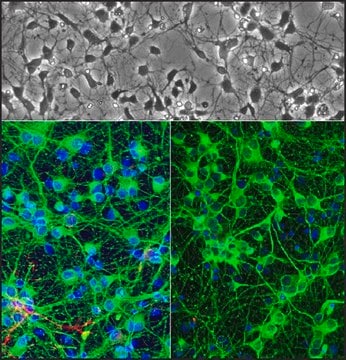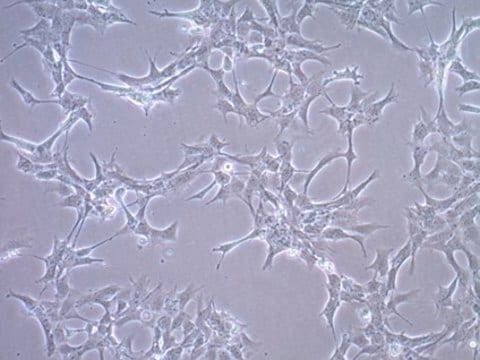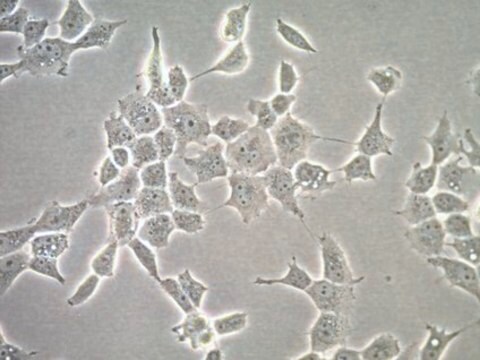SCC129
HT-22 Mouse Hippocampal Neuronal Cell Line
HT-22 mouse neuronal cell line is a valuable cell model for studies of glutamate-induced toxicity in neuronal cells.
Sinônimo(s):
HT22 Cell Line
Faça loginpara ver os preços organizacionais e de contrato
About This Item
Código UNSPSC:
41106514
eCl@ss:
32011203
Produtos recomendados
fonte biológica
mouse
Nível de qualidade
técnica(s)
cell based assay: suitable
Condições de expedição
dry ice
Categorias relacionadas
Descrição geral
Glutamate is a major excitatory neurotransmitter used as a signaling molecule between nerve cells and is involved in most aspects of normal brain function including cognition, learning and memory. Various glutamate receptors are found throughout the brain and include NMDA, AMPA/kainate and metabotropic receptors (mGluR). Normal glutamate levels are essential for normal brain function, however high levels may result in over-excitation of nerve cells, leading to eventual cell damage and/or cell death. Glutamate-induced cytotoxicity has been implicated in neurodegenerative disorders such as Alzheimer’s disease, Huntington’s disease and Parkinson’s disease along with other conditions including spinal cord injury and multiple sclerosis. Therapies that may inhibit or reduce the effects of glutamate activity are thus of great therapeutic interest.
HT-22 is an immortalized mouse hippocampal cell line subcloned from the HT-4 cell line . The parental HT-4 cell line was derived from the immortalization of mouse neuronal tissues with a temperature sensitive SV40 T-antigen . HT-22 is highly sensitive to glutamate and is thus frequently used as a model system to study glutamate-induced toxicity in neuronal cells.
Descrição de linhagem celular
Neural Lineage Cells
Aplicação
EMD Millipore has a limited license to sell this product for research use only, and not for any commercial uses. Excluded commercial uses include without limitation manufacturing, providing a service, therapeutic, diagnostic and prophylactic uses, and any other commercial uses. Use of this product by a purchaser for any purpose other than for research is unauthorized and prohibited.
Inquiries about licensing for commercial or other uses should be directed to:
Office of Technology Development
The Salk Institute for Biological Studies
10010 North Torrey Pines Road
La Jolla, CA 92037
Phone: (858) 453-4100 extension 1278
Email: OTD@salk.edu
Inquiries about licensing for commercial or other uses should be directed to:
Office of Technology Development
The Salk Institute for Biological Studies
10010 North Torrey Pines Road
La Jolla, CA 92037
Phone: (858) 453-4100 extension 1278
Email: OTD@salk.edu
Research Category
Neuroscience
Toxicity
Neuroscience
Toxicity
Qualidade
• Each vial contains ≥ 1X106 viable cells.
• Cells are tested negative for infectious diseases by a Mouse Essential CLEAR panel by Charles River Animal Diagnostic Services.
• Cells are verified to be of mouse origin and negative for inter-species contamination from rat, chinese hamster, Golden Syrian hamster, human and non-human primate (NHP) as assessed by a Contamination Clear panel by Charles River Animal Diagnostic Services.
• Cells are negative for mycoplasma contamination.
• Cells are tested negative for infectious diseases by a Mouse Essential CLEAR panel by Charles River Animal Diagnostic Services.
• Cells are verified to be of mouse origin and negative for inter-species contamination from rat, chinese hamster, Golden Syrian hamster, human and non-human primate (NHP) as assessed by a Contamination Clear panel by Charles River Animal Diagnostic Services.
• Cells are negative for mycoplasma contamination.
Armazenamento e estabilidade
Store in liquid nitrogen. The cells can be cultured for at least 10 passages after initial thawing without significantly affecting the cell marker expression and functionality.
Código de classe de armazenamento
12 - Non Combustible Liquids
Classe de risco de água (WGK)
WGK 2
Ponto de fulgor (°F)
Not applicable
Ponto de fulgor (°C)
Not applicable
Certificados de análise (COA)
Busque Certificados de análise (COA) digitando o Número do Lote do produto. Os números de lote e remessa podem ser encontrados no rótulo de um produto após a palavra “Lot” ou “Batch”.
Já possui este produto?
Encontre a documentação dos produtos que você adquiriu recentemente na biblioteca de documentos.
Kyung-Ran Kim et al.
Experimental & molecular medicine, 53(7), 1134-1147 (2021-07-09)
Calbindin, a major Ca2+ buffer in dentate granule cells (GCs), plays a critical role in shaping Ca2+ signals, yet how it regulates neuronal function remains largely unknown. Here, we found that calbindin knockout (CBKO) mice exhibited dentate GC hyperexcitability and
J B Davis et al.
Brain research, 652(1), 169-173 (1994-07-25)
A neuronal cell line, HT-22, is sensitive to glutamate cytotoxicity via a non-receptor mediated oxidative pathway. 12-O-tetradecanoylphorbol-13-acetate (TPA), an activator of protein kinase C, blocks this glutamate-induced cell death. Down-regulation of protein kinase C eliminates the protection against glutamate cytotoxicity
Mitsuaki Nishikimi et al.
Annals of neurology, 91(3), 389-403 (2022-01-04)
Cardiac arrest (CA) is a major health burden with brain damage being a significant contributor to mortality. We found lysophosphatidylcholine (LPC), including a species containing docosahexaenoic acid (LPC-DHA), was significantly decreased in plasma post-CA, supplementation of which significantly improved neurological
Peng Huang et al.
Annals of translational medicine, 9(20), 1594-1594 (2021-11-19)
Phosphodiesterase 4D (PDE4D) inhibitor is commonly used to treat depression, but side effects seriously decrease its efficacy. PDE4D was a downstream target mRNA of miR-139-5p. Therefore, we examined the effects of hippocampal miR-139-5p gain- and loss-of-function on depression-like behaviors, the
Oliwia Koszła et al.
Molecules (Basel, Switzerland), 27(7) (2022-04-13)
Neurodegenerative and mental diseases are serious medical, economic and social problems. Neurodegeneration is referred to as a pathological condition associated with damage to nerve cells leading to their death. Treatment of neurodegenerative diseases is at present symptomatic only, and novel
Nossa equipe de cientistas tem experiência em todas as áreas de pesquisa, incluindo Life Sciences, ciência de materiais, síntese química, cromatografia, química analítica e muitas outras.
Entre em contato com a assistência técnica






